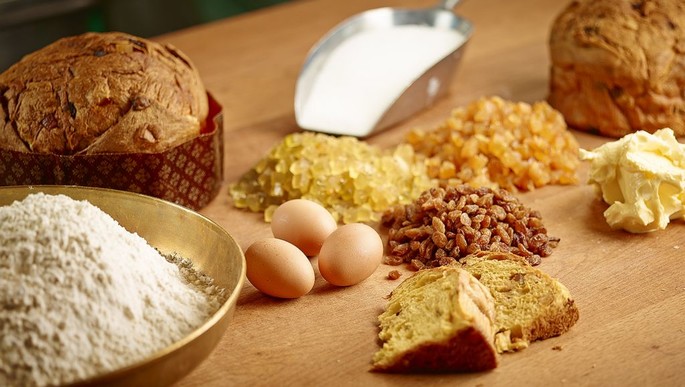Here is the ancestor of the panettone: the recipe of the Ferrara court of Este prescribes to use flour, butter, sugar, eggs, milk and rose water; the bread "you will leave it well up", "you will cook it with great order", "this bread is more beautiful to make it round" or even "bigger or more little, as you will want". We rediscover the basic components of the panettone and, above all, the prescription that must be very leavened ("you will leave it well up"), to which is added the indication of the shape: round. As you can see, this is a panettoncino a bit lean and low, without raisins and candies, but the elements to continue are all there.
Some centuries must pass before the panettone takes the form and substance with which we know it today. Of course, the funny stories on the kitchen porter of the Sforza called Toni who saves the court chef preparing a cake with the leftovers instead of what had burned, are legends. Funny, but there's nothing true. The reality is much more banal: panettone means big bread and falls into the category of Christmas cakes. We are in an era, the late Middle Ages, in which sugar is a very precious commodity and therefore to emphasize the festivities, the normal bread that is baked (more or less) every day, is sweeten. Throughout Italy, festive breads - not necessarily Christmas - are made with various names: panün valtellinese, pandolce genovese, panspeziale bolognese, panforte senese, panpepato umbro-toscano, pangiallo laziale. The dough is sweetened with sugar and embellished with almonds (in Bologna), with pine nuts (Genova), and also with mustard, raisins or dried figs. It will only be Milan's Christmas bread to leave the local borders and become the sweet prince of Italian Christmas.

[Credit Popo le Chien]
The panettone son of industrialization
Milan in the nineteenth century is said to be the main manufacturing center of the peninsula and also imposes its Christmas cake. Already in the second half of the century the Milanese pastry cooks sent panettone to everywhere. The names of Cova, Biffi, Tre Marie, Baj, Marchesi become known everywhere. One starts to donate panettone, sweets from high middle class, expensive, because rich in quality ingredients. Both Gioacchino Rossini and Giuseppe Verdi in a letter thank the musical publisher Ricordi for the tribute of a panettone. At the end of the nineteenth century the cake became a bicker between the composer Giacomo Puccini and the conductor Arturo Toscanini; the first one sends a panettone for Christmas to the second, a man with a notoriously rough character. Then the two quarrel, and Puccini sends a small telegram to Toscanini: "Panettone sent by mistake," he writes. To which Toscanini replies in kind: "Panettone eaten by mistake".

[Pandoro, credit Kuebi]
The first patent is from 1894
Panettoni that, attention, are low. To find the leavened desserts we know today we have to go to Verona where Domenico Melegatti has the idea to fill the traditional Verona Christmas cake, nadalin, with butter and eggs, so that it rises to unknown heights. In 1894 he patented it to settle the controversies with other confectioners who attributed the paternity of the sweet. The name derives from the Renaissance tradition of covering the loaves with gold leaf to show off its wealth, as on the occasion of the banquet organized in Bologna on 29 January 1487 by Giovanni II Bentivoglio to celebrate the marriage of his son Annibale with Lucrezia d'Este. Melegatti was a rather enterprising man and he challenged the panettone by opening a shop in the heart of the opposing territory, in Milan, in that same Corso Vittorio Emanuele where the Tre Marie had its home. Starts mail order and send them all over the world.

[Credit Ben Hanbury]
The dessert born of a commendatore incline to anger
To get to the high panettone, to the three canonical leavenings, we must wait Angelo Motta, who after opening his own shop, in 1919, applies to Panettone the same treatment that Melegatti had reserved for pandoro. Orio Vergani writes: "He considerably increases the doses of butter, eggs, sugar and candied fruit, modifies and increases the time of leavening and cooking and, because the pasta, so treated, becomes softer, to support he uses the ingenious and simple solution of wrapping in a crown of paper: this is how Motta's panettone is born".
Here is another parallel between panettone and pandoro: both, to rise so much, require a very soft paste that needs a support to remain of the desired shape, Melegatti has invented the star-shaped mold, Motta the crown of paper. Metal molds are more expensive, but reused, paper, on the other hand, is cheap, but to throwaway. Another parallel is the race between rival competitors: at Verona between Melegatti and Bauli, in Milan between Motta and Alemagna.
Angelo Motta is the classic industrial man who came from nowhere and, unlike the good-natured peddling with both hands in his publicity, is an irascible: "we remember the panettone carts overturned badly, because they do not conform to the quality he demanded". The industrial Mobbi, the bad guy who calls the police to dislodge the slums, in one of the most famous films of Italian neorealism, Miracolo a Milano, by Vittorio De Sica (1951), is exactly his figure, among other things identifiable also from the assonance of the surname. And it seems a paradox that the sweet symbol of Christmas goodness was produced by an industrialist, instead remembered for the outbursts of anger.















